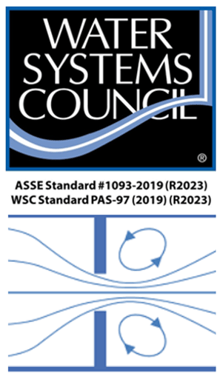Does Boshart offer “Flood Proof” well caps to protect against well contamination?
NO!
However, we do offer solutions which are covered later in this article!
From time to time, we have been asked for a “Flood Proof” well cap similar to the WDB well cap. We do not offer such an item. In this article, we will cover why we do not offer well caps with the built in rubber “check valves” at the downward facing air vents.

WHY? These WDB so called “Flood Proof” - “Double Check Valve” well caps are neither flood proof nor do they have “check valves”. A check valve by definition is a one-way valve! The bottom line is that these caps, in our opinion, pose a serious product liability / safety risk.
They are being promoted with this description: “WTC-XXX Watertight Thermoplastic Resin Vermin Proof (Flood-Proof) Well Cap With 1-1/4" IPS Conduit Connection & Double Check Valve To Let The System Breathe and Maintain Its Watertight Integrity. Works With PVC or Steel Casing.”
The rubber gasket incorporates a slit in its raised bosses that allows the well to breathe. As the water level drops during the pump-down cycle, the rubber flexes upward to let air into the well and fill the void. When the pumping cycle is completed the rubber flexes downward to allow the aquifer to replenish the well back to standing static water level. The air in the well casing must be allowed to escape so that the water level can rise within the well casing in preparation for the next pump cycle. Therefore, air is allowed to move in and out of the well. If you were to have a flood condition in which the well head / cap was submersed, the rubber slit will operate in the same way however instead of drawing in or expelling air you will draw in contaminated surface water.

 The claim being made on these well caps is simply not factual, misleading one to believe that the well is protected against flood water contamination during a flood. It is not!
The claim being made on these well caps is simply not factual, misleading one to believe that the well is protected against flood water contamination during a flood. It is not!

Furthermore, the small slit (cut) in the rubber (which
would be more accurately described as “Flow Restrictors” than a check valve), severely restricts the air flow in and out of the well chamber, hampering the well’s ability to breathe. The screened vents in this cap and many other brands of well caps do not meet the air vent open area for water well construction codes as defined in the Well Cap Standard.
“ASSE Standard #1093-2019/WSC Standard PAS-97 (2019) PAS-97”.
Section 3.6 details the vent diameters and open area information!


Flood protection requires a TRULY watertight well cap!
 Water well construction codes vary depending on the area you live, and it is very important that you adhere to all applicable national and local water well construction codes when venting well caps in flood zone areas.
Water well construction codes vary depending on the area you live, and it is very important that you adhere to all applicable national and local water well construction codes when venting well caps in flood zone areas.
A true watertight cap would require that the well cap does not have any venting that would be below the maximum flood level designated for the area. For installation the vents must be removed, the BOSHART industrial type well caps with “Mushroom Type” vents installed in the top cover are easily converted.

The photos below detail two possible options to protect the well from surface water contamination in a flood condition. In option #1 the vent is raised above possible flood level on a riser pipe with the screened air vent above the maximum flood level. In option #2 an approved air release valve with floating ball is plumbed to the well cap vent port. The floating ball rises with the flood water and shuts off the air passage in the event flood waters rise above the air inlet/outlet at the well head. During normal conditions the ball is down, and the air passage is open to allow air in and out of the well.

Converting WTCC and WTC series well caps from vented to raised vents!
Boshart’s standard WTCC and WTC series well caps (Vermin Proof, Vented, “Watertight” caps), can be converted, however it does take some time and effort. The vents need to be removed, and the vent ports must be sealed. The top covers are supplied with a raised boss to allow for drilling and threading with a 1” FPT port in which a riser pipe can be installed to add a raised mushroom type vent above flood level in the geographic are in which the well is located. Always ensure the installation will meet all applicable national and / or local water well construction codes.

Additional Resources:
https://support.boshart.com/is-a-water-tight-well-cap-watertight
https://assewebstore.com/asse-standard-1093-2019-r2023-wsc-pas-97-2019-r2023/
